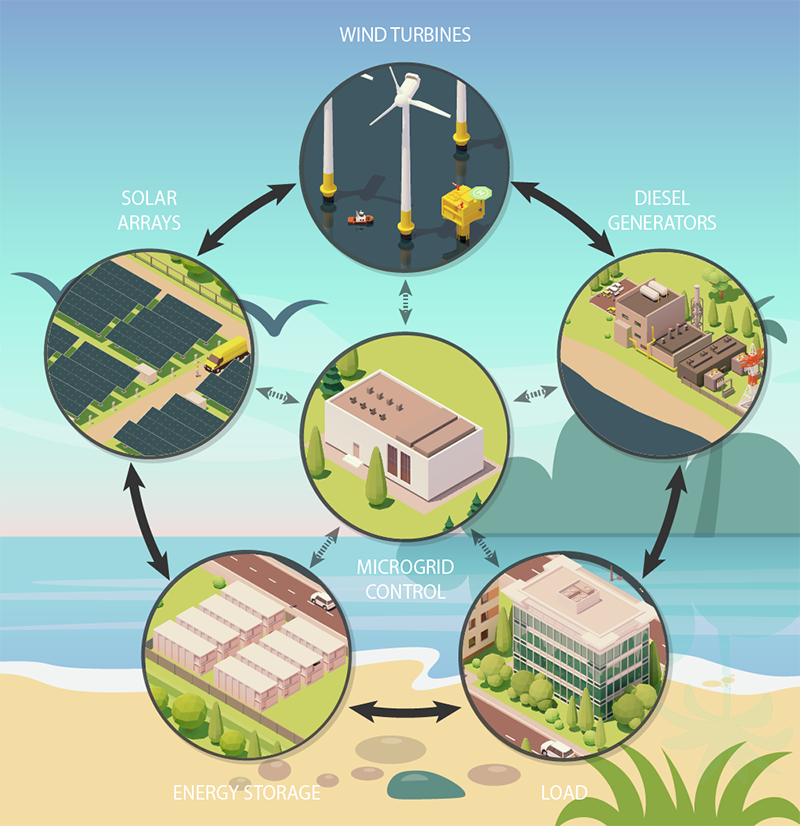Examples on where microgrids are used
Microgrids have many different application cases. Check out the real-life examples on where microgrids are used.
By Aytek Yuksel, Content Marketing Leader - Power Systems

Microgrids are small-scale electricity networks. They are power systems which both generate and distribute electricity. Some microgrids are connected to the main electricity grid; others are not connected by choice or because there is no main electricity grid to connect to.
Modern wide-area electricity grids are vast interconnected systems consisting of millions of electricity consumers and thousands of electricity generators. In Canada and in the United States, for example, the Western Interconnection covers most of the territory west of the Great Plains. It includes about 136,000 miles of high voltage transmission lines, in addition to medium and low voltage distribution lines. A complex patchwork of dozens of utilities, system operators and other entities maintain, operate and regulate it.
Microgrids, in contrast, cover a local area, don’t normally include high voltage transmission lines, and connect far fewer consumers and providers. Typically, private microgrids are owned and operated by the same entity that also owns the load served by the microgrid. Public microgrids serving, for example, an island, are typically owned and operated by a local municipal utility.
Simple microgrids have existed for as long as public electricity service has been available. However, in recent years, the explosive rise in renewable electricity has led to more microgrids being deployed. These modern microgrids incorporate more sophisticated technology. They typically connect a variety of assets including solar arrays, wind turbines, gas or diesel generators, and battery energy storage.
Microgrids used in island grids
Islands that are too small or too distant to warrant building an electric connection to the mainland are required to operate their own microgrids. Traditionally, island microgrids have relied on diesel generators to provide all or most of their electricity. Generators are perfect for island applications because of their flexible operation. Generators can start up quickly, and a power plant inclusive of multiple generators can effectively cover a very wide load range. Liquid fuels are also the traditional fuels of choice for island power plants because they are easy to transport and store.

Many islands have seen their residents increasingly dissatisfied with this setup however. Older generators can impact the air quality locally, which can be particularly undesirable for islands that rely on tourism. For islands with few economic resources, the cost of shipping liquid fuel can also be a major burden.
Such islands are turning towards solar and wind generation as ways to reduce their dependence on fossil fuels. A smart microgrid integrating a mix of renewable resources, generators and battery energy storage systems can effectively make electricity more affordable and more reliable, while also reducing the environmental impact of the electricity production.
Modern control systems can be programmed with all the parameters of the various distributed energy resources to run the microgrid in order to maximize the use of renewables and minimize imported fuel use. An important benefit is extra resiliency for the grid, avoiding blackouts and brownouts across the network.
An example would be Calvert Island in British Columbia, Canada, where Cummins Inc. was involved in a project to upgrade the island’s microgrid. The island needed more power but was reliant solely on diesel generation. The island upgraded to a microgrid with solar arrays, battery energy storage and new Cummins diesel generators. The upgrade resulted in fossil fuel consumption being reduced by 83%.
Microgrids used in remote locations
Industrial facilities and settlements located in remote locations with no access to utility service face the same difficulties as islands. These facilities have historically used diesel generators. Fuel needs to be transported, sometimes via truck over long distances in challenging terrains. For mines located in Northern Canada or in remote parts of Australia, for example, the cost of transporting the fuel can easily exceed the cost of the fuel itself. In some regions of the world, such as remote regions of Alaska and northern Canada, transportation of fuel must also take into consideration the changing seasons when road and water ways will allow for transportation vehicles and vessels.
Industrial operations, in addition, need robust systems to guarantee electricity supply. If a mine’s ventilation system comes to a halt because of a power failure, for example, conditions may quickly degrade for workers underground.
Such operations are keen to take advantage of locally available renewable resources to reduce costs and ensure safety. Reducing fuel costs by even a small percentage at a large-scale mining operation can rapidly result in substantial savings.
An example of a mining microgrid is the Agnew gold mine in Western Australia, where Cummins took part in the project to construct a power complex to supply the mine. The site decided on an off-grid 23 MWe power plant made up of 16 MWe gas, 4 MWe solar and 3 MWe diesel power generation. A further 2 MWe of gas-powered generation was added, followed by 18 MWe of wind generation and a 13 MWe energy storage battery and advanced control system. Over half of the 56 MWe capacity hybrid plant is from renewable resources.
Cummins also took part in a project to upgrade the power supply at Fisherman’s Landing marina off of Vancouver Island in British Columbia, Canada. During summer, the marina accommodates large yachts where the yachts are provided with electrical service. As a result, the marina’s electrical consumption would experience significant seasonal changes. The marina installed a microgrid incorporating solar power for the low season and diesel generation for the high season. Thanks to the new microgrid, yacht owners can now connect to the marina’s electrical service, and switch off their on-board engines and generators to enjoy the quiet and calm of Desolation Sound.
Microgrids used for onsite generation
Microgrids are not exclusive to remote areas. Any facility seeking to integrate multiple loads and multiple on-site generation resources should consider building a microgrid, whether a connection to the main utility service is available or not.
Military bases often utilize microgrids on their premises for security reasons despite being connected to a utility grid. In Hawaii, for example, the U.S. Navy is in the process of building an extensive microgrid to cover Joint Base Pearl Harbor-Hickams. The Navy’s project includes several hundred megawatts of solar generation, energy storage, as well as an extensive electrical backbone connecting dozens of buildings and facilities. Outside of emergencies, the Navy’s generation assets will provide power to the local utility.
Other facilities may decide to build a microgrid to simply reduce electricity and energy costs. With intelligent controls, microgrid consumers can switch between grid service and self-generation depending on what is most economical.
A network of microgrids comprised of various distributed energy resources attached to the main grid also adds resiliency to the whole electrical system, as the grid operator can arrange to utilize these resources as and when necessary. As extra generation is produced and consumed on site, this alleviates pressure on the main grid and translates into less need for investment for upgrades to the distribution network.
However and wherever microgrids are used, the intelligent systems and technologies now available to integrate renewable resources into local electricity schemes mean that, in economic and societal terms, owners have the opportunity to go renewable while benefitting from cost-effective electricity.
Interested in more on microgrids? You might also like:
- Benefits of microgrids, and why do businesses need them?
- Types of microgrids, with examples
- Components of microgrids
- What is a microgrid and how microgrids work
Sign up below for Energy IQ to receive energy focused insights in markets ranging from data centers and healthcare facilities, to schools and manufacturing facilities, and everything beyond.
Author Profiles

Aytek Yuksel, Content Marketing Leader - Power Systems
Aytek is a marketing leader at Cummins, focusing on technology and thought leadership. Since joining in 2008, he has held various marketing roles and now shares insights on markets, technologies, and energy transition. Aytek lives in Minneapolis with his wife and two kids.
Related Tags